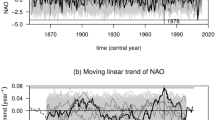Abstract
The Mark 2 version of the CSIRO coupled global climatic model has been used to generate a 1000-year simulation of natural (i.e. unforced) climatic variability representative of “present conditions”. The annual mean output from the simulation has been used to investigate the occurrence of decadal and longer trends over the globe for a number of climatic variables. Here trends are defined to be periods of years with a climatic anomaly of a given sign. The analysis reveals substantial differences between the trend characteristics of the various climatic variables. Trends longer than 12 years duration were unusual for rainfall. Such trends were fairly uniformly distributed over the globe and had an asymmetry in the rate of occurrence for wet or dry conditions. On the other hand, trends in surface wind stress, and especially the atmospheric screen temperature, were of longer duration but primarily confined to oceanic regions. The trends in the atmospheric screen temperature could be traced deep into the oceanic mixed layer, implying large changes in oceanic thermal inertia. This thermal inertia then constituted an important component of the `memory' of the climatic system. While the geographic region associated with a given trend could be identified over several adjacent grid boxes of the model, regional plots for individual years of the trend revealed a range of variations, suggesting that a consistent forcing mechanism may not be responsible for a trend at a given location. Typical return periods for 12-year rainfall trends were once in 1000 years, highlighting the rarity of such events. Using a looser definition of a trend revealed that drying trends up to 50 years duration were also possible, attributable solely to natural climatic variability. Significant (∼20% to 40%) rainfall reductions per year can be associated with a long-term drying trend, hence such events are of considerable climatic significance. It can take more than 100 years for the hydrologic losses associated with such a trend to be overcome. Overall, the simulation provides new and useful insights into climatic trends, and quantifies a number of poorly observed characteristics. The results highlight the extensive and pervasive influence of unforced natural climatic variability as an omnipresent generator of climatic trends.
Similar content being viewed by others
Author information
Authors and Affiliations
Additional information
Received: 20 January 2000 / Accepted: 21 September 2000
Rights and permissions
About this article
Cite this article
Hunt, B. A description of persistent climatic anomalies in a 1000-year climatic model simulation. Climate Dynamics 17, 717–733 (2001). https://doi.org/10.1007/s003820000138
Issue Date:
DOI: https://doi.org/10.1007/s003820000138




